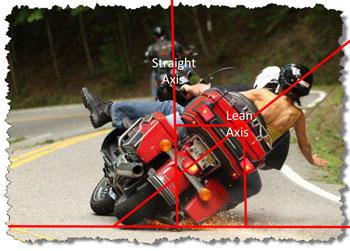 I love watching motorcycle racing. Speed, knees down and nerves of steel.
I love watching motorcycle racing. Speed, knees down and nerves of steel.
I remember getting my first Yamaha FZ-1. I loved that bike. I was lean and mean, and I felt invincible. I remember taking curves with my knees hanging down just trying to be as cool as those superstar racers on TV. My adrenaline was pumping, and I knew I was hitting those 150 mph speeds. In reality, I was probably doing about 30 mph, and my knees were nowhere near the pavement. It was a good thing too, because all I had on was a pair of blue jeans.
When we ride straight up, our body, bike and gravity make an invisible line that is vertical. This is the straight axis, which is the combination of the bike and rider combined. As we enter a curve and lean, the axis line stays vertical, but our angle, speed and gravity combine to move the bike’s center of gravity, and the new axis moves inward or outward.
On the outside, motorcycling is just a fun sport. On the inside, it is machinery and science. To understand our ability to take curves, let’s looks at Newton’s laws of motion.
Newton’s first law of motion states that every object will remain at rest or in motion in a straight line unless something changes by the actions of external force.
A stopped motorcycle will stay stopped until force is applied to make it move. Twist the throttle, and the action is transferred throughout the bike to the rear tire so you move forward. Once moving, the bike will continue to move in a straight line until an external force makes it change.
Newton’s second law states that the velocity of an object changes when it is subjected to an external force.
This law can be applied to how we move our weight, lean, or push the handle bars in the case of counter steering. There are so many ways that one can turn a motorcycle. Our riding position, gravity, speed of the bike, the rate of the turn and force all form the equation of a turn.
Riders can do little things to make their turns more controlled. If you place your feet inward on your foot pegs and press your knee against the tank in the direction you want to turn, your weight
will shift ever so slightly, and your bike will start to turn in response.
Newton’s third law states that for every action (force), there is an equal and opposite reaction. As we watch the racer take the curve, the rider leans off the bike. If you could see into his helmet, you would see his eyes focused on where he wants to go. As he approaches the turn, his eyes, mind and body have already calculated an angle to take the curve, and his body shifts as he moves into the turn. The speed of the bike compresses the shocks. The weight and lean of the bike keep it balanced throughout the turn.
Riding and understanding the science of motorcycling is one thing. It is another to do it. If you think that you want to actually get your knees down and take turns as fast as a racer, I would strongly suggest going to a riding school. They will ensure your bike is set up correctly and that you wear the proper protective gear. With a clean track, good visibility and professional help, they will teach you how to be a superstar – safely.
If there is a topic that you would like to discuss, you can contact me at motorcycle4fun@aol.com. RIDE SAFE!

 How to resolve AdBlock issue?
How to resolve AdBlock issue? 









